The World Cup kicks off this month as the entire planet gets ready to watch the greatest festival of football within the sport.
Lovers of the beautiful game have been forced to wait four and a half years for all four corners of the globe to meet in this glorious tournament to decide who the best footballing nation in the world really is.
Europe have been victorious in every rendition since Brazil’s last triumph in 2002, but with the European sides all underperforming over the past twelve months, with the exception of the Netherlands, it may provide another continent with the opportunity to take the golden trophy home.
In 92 years of history, an African nation has never been crowned victor of the World Cup, which is more of an indictment of the financial disparities within football and the failings of the geopolitical structure of the globe than anything else.
This time around, Ghana, Cameroon, Morocco, Tunisia and Senegal will all vie against one another and the other 27 nations in an attempt to make history.
One of the African countries with the best chance of progressing from the group phase is Cameroon. Led by former defender and the ever-stylish Rigobert Song, the Indomitable Lions will go to war against the European trio of Brazil, Serbia and Switzerland in Group G.
While perhaps being the underdogs out of the four, Song’s Cameroon will not be a team to underestimate, having won five from six qualifiers against the Ivory Coast, Mozambique and Malawi before putting Algeria to the sword in the playoff to reach the promised land.
Having qualified for their eighth World Cup in history, Cameroon will be hoping to better their feat of reaching the quarter-finals during Italia 90’. Can this be the year they go one step further against all the odds?
This article will be a scout report of Cameroon, using tactical analysis to observe the tactics that Song will likely use at the World Cup. It will be an analysis of what to expect from the African giants.
Predicted Starting XI
Since taking the job mid-calendar year, Song has deployed a plethora of different formations with Cameroon. Given the side’s strength in depth in the midfield department, the manager has been able to chop and change the shape depending on the opponent.
Primarily, Cameroon shift between conventional back four systems, setting up in a 4-4-2, a 4-3-3, or its close cousin 4-1-4-1, as well as the 4-2-3-1, although this has been the structure least used by the Cameroonians.
Given that Cameroon will potentially be forced to drop off and defend for large parts of their games, particularly against the possession-dominant Brazil and Serbia, Song will likely line his players out in a 4-4-2 to cover the width of the pitch and offer perfect defensive balance, although one shouldn’t be surprised to see a 4-1-4-1 either.
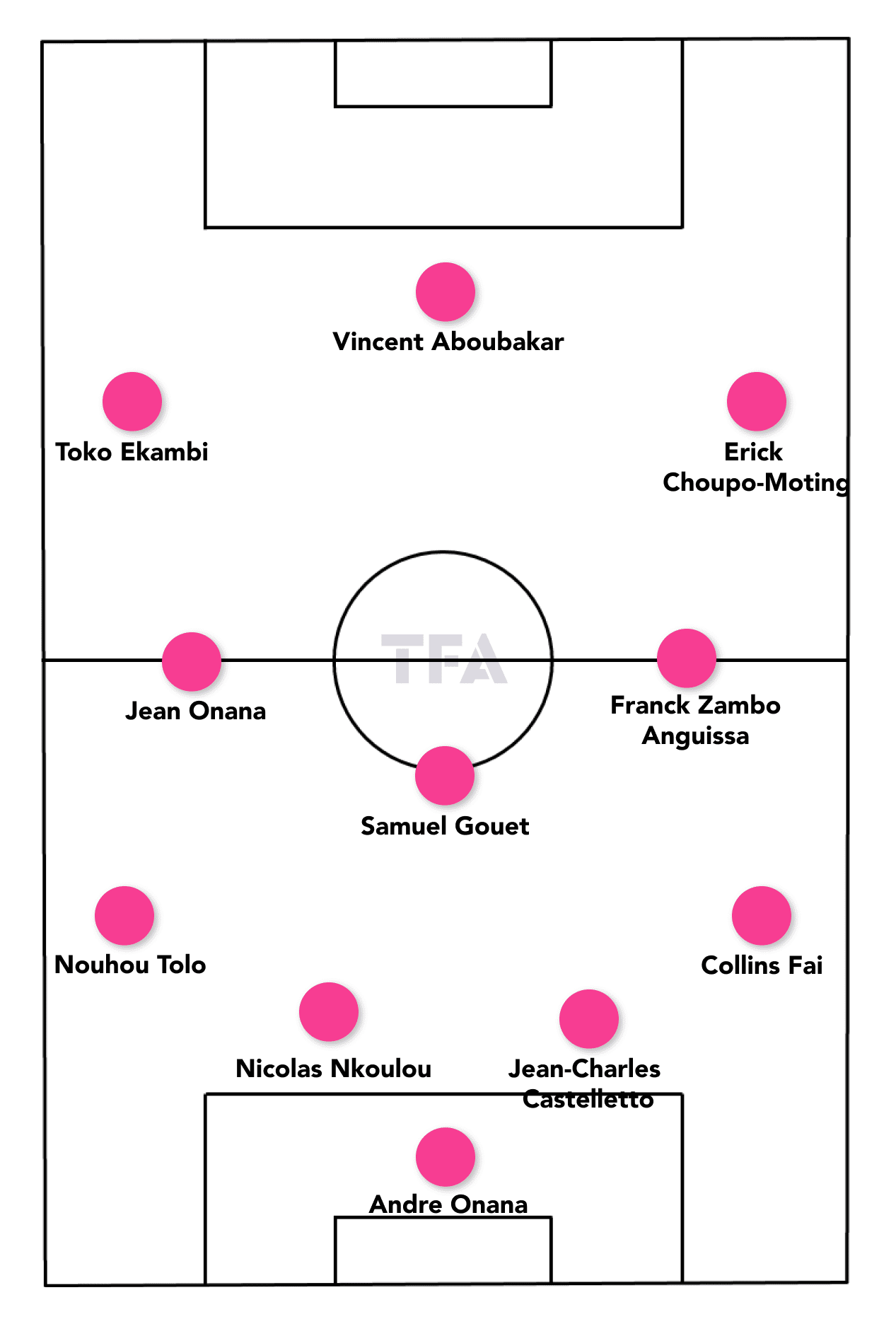
In the African Cup of Nations, which was hosted by Cameroon itself, the Indomitable Lions had an average age of 27.4 which was the eleventh-oldest squad in the competition or the 14th youngest from all 24 teams, depending on whether you choose to see the glass half full or half empty.
This time around, there will likely be the same core group of players which is very Euro-centric now, including Napoli star Franck Zambo-Anguissa, Lens midfielder Jean Onana, KV Mechelen’s Samuel Gouet, Lyon’s Karl Toko Ekambi and even Bayern Munich striker Eric Maxim Choupo-Moting.
Even Brentford’s Bryan Mbeumo may be given the nod by Song in the forward line as well as Georges-Kévin Nkoudou, showing the depth that the manager has in this area of the squad.
While Cameroon’s side is certainly not youthful, with the exception of a few players, the squad isn’t too old either, with most players currently teetering around their primes.
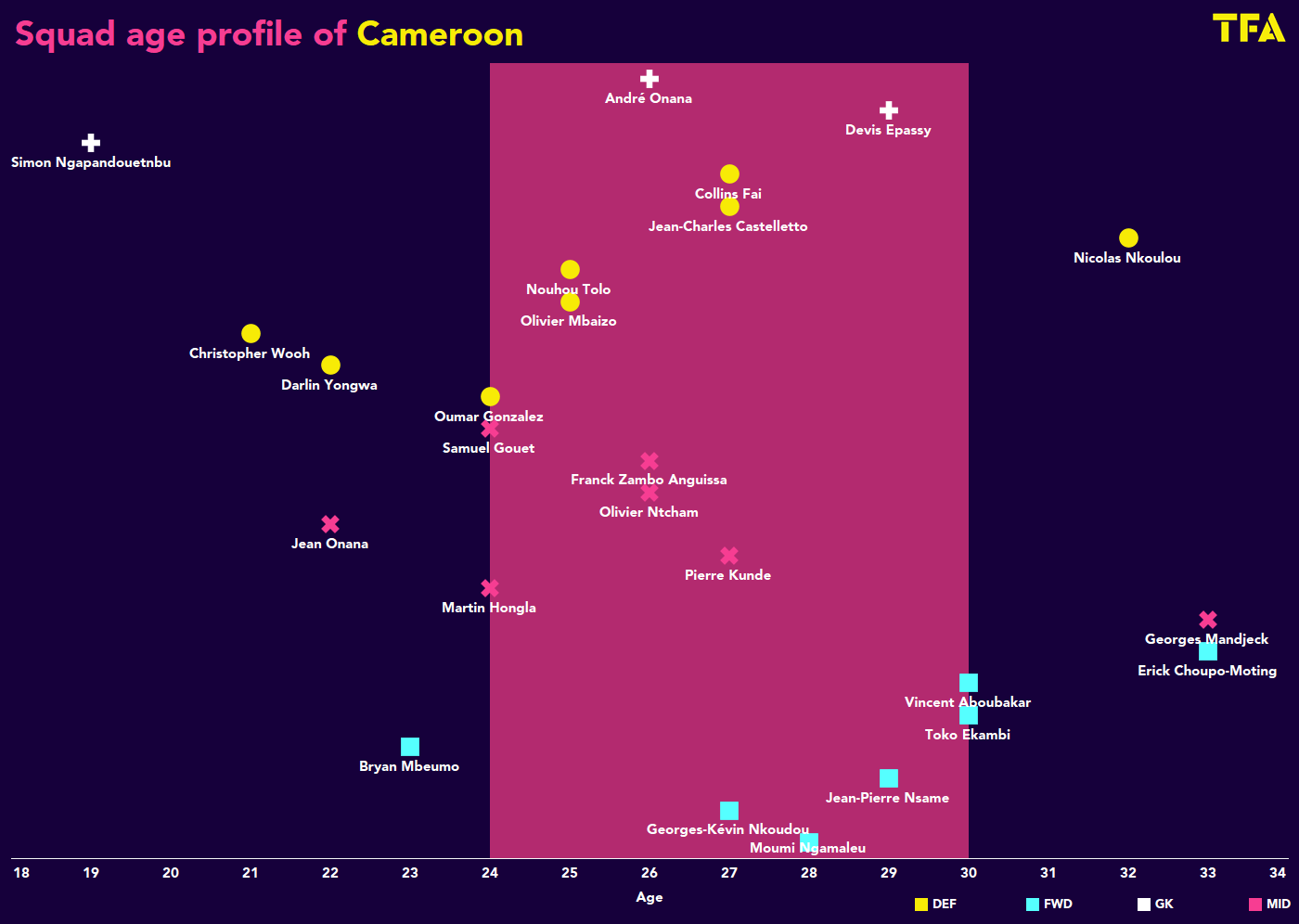
Overall, Song has brought a nice blend with him to Qatar in terms of the disparity of ages. Within the squad, there is some experience to help keep the team calm during manic situations, some younger players to play without fear at their first-ever World Cup and a plethora of players at their peak to provide the bulk of the quality.
Attacking phase
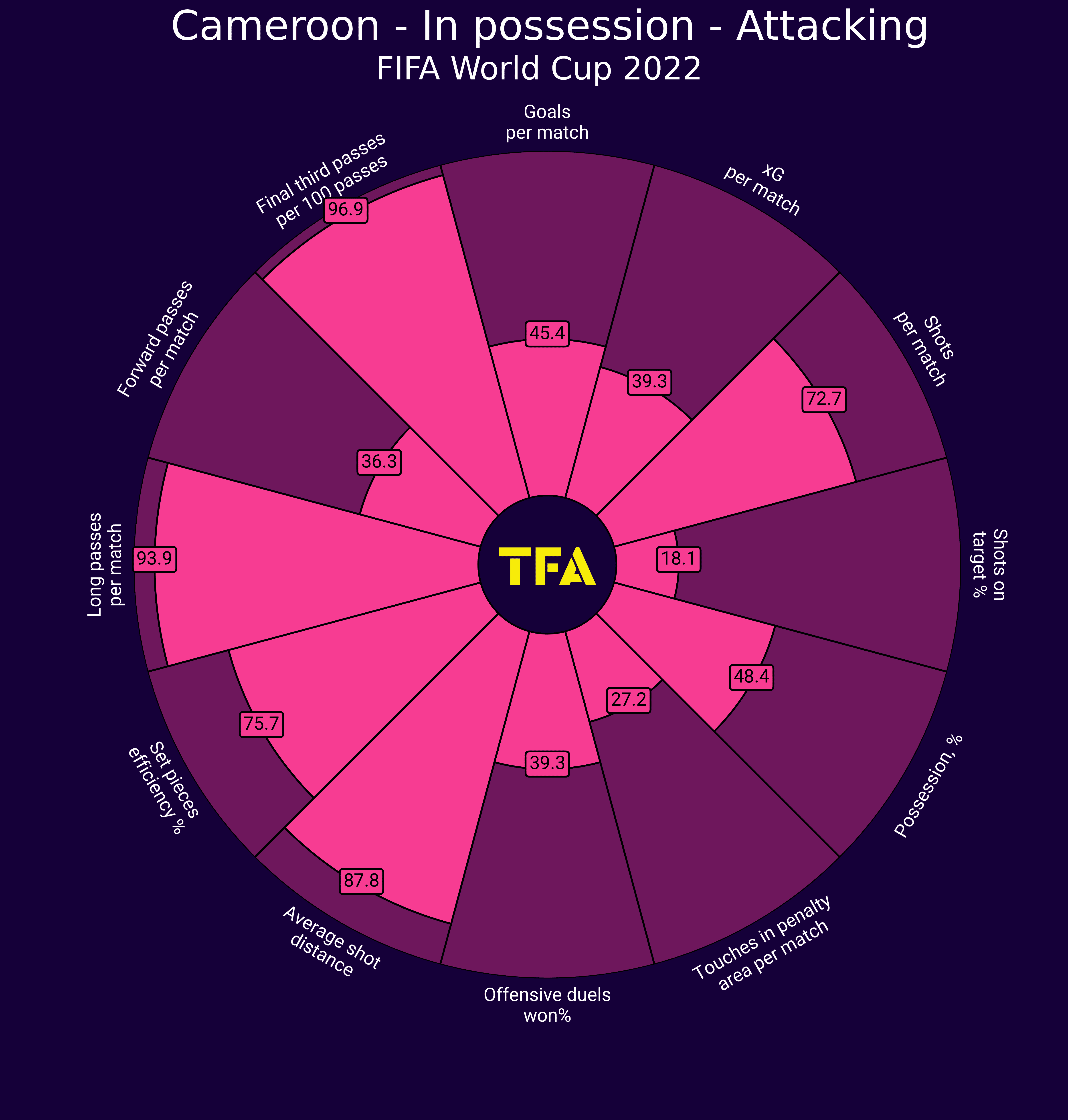
Over the course of 2022 so far, Cameroon have boasted 56.34% of the ball per game, on average. During the AFCON last year, the side held the third-highest possession average in the competition at 58.4%, losing only to Morocco and Algeria who had higher numbers.
However, Cameroon’s numbers are greatly inflated due to Song’s team playing a lot of worse opposition with far fewer high-class players among their ranks. In games where the Indomitable Lions face better opponents, they tend to cede possession quite a lot.
For instance, in Cameroon’s recently friendly against South Korea, the African giants had merely 38.68% of the ball and lost 2-0.
In possession, Song is quite relaxed about his players having possession of the ball. It would be far from correct for any pundit to call Cameroon a possession-oriented team. This is because on the ball, particularly during the build-up phase, the manager is keen to play rather direct.
Cameroon do like to position themselves to play out from the back, giving off a façade that they will pass it short from the goalkeeper and try to build up from the first third to the final third.
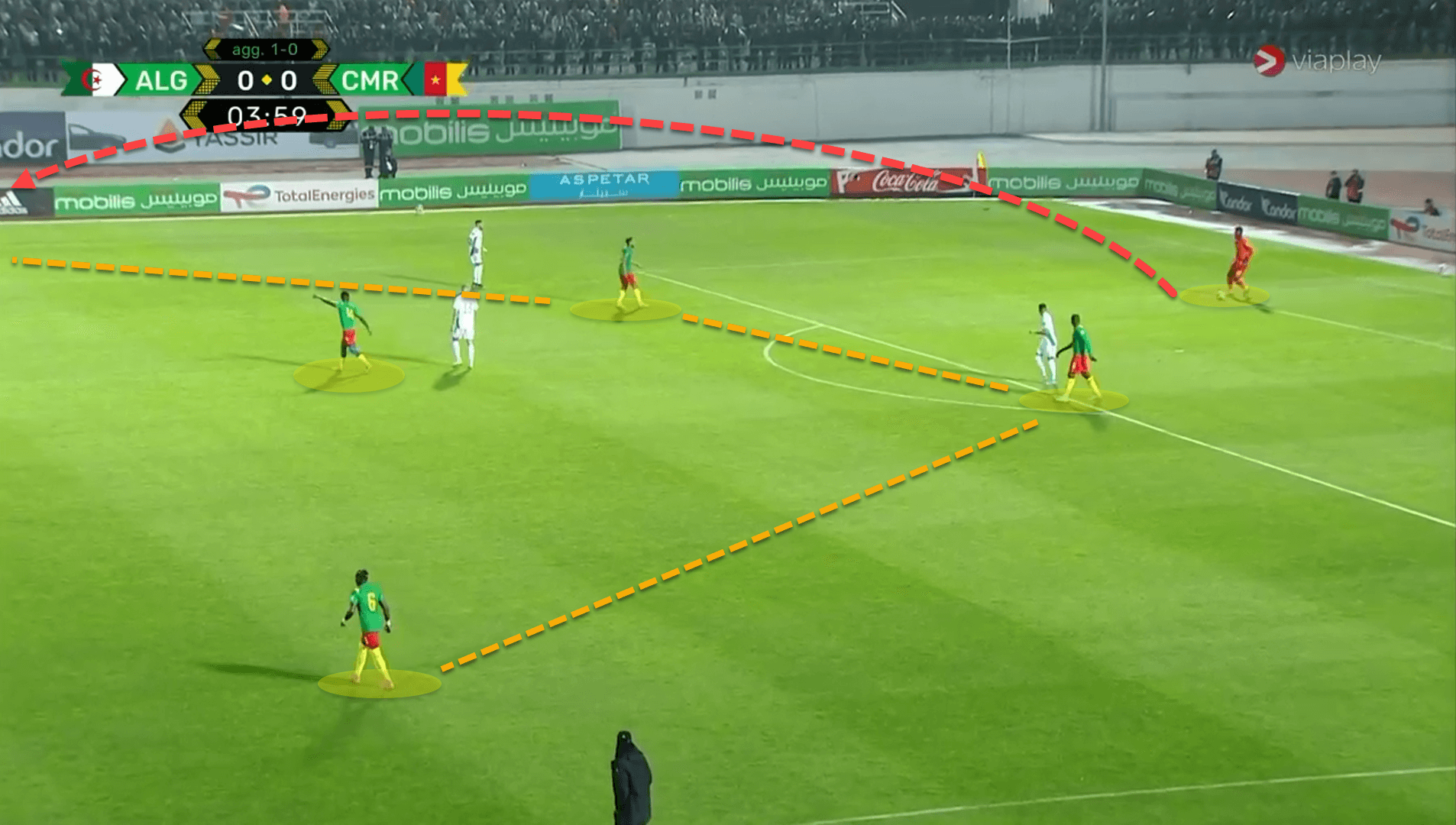
When the Cameroonians do so, the centre-backs split wide to accommodate the higher positioning of the goalkeeper while the fullbacks move up the pitch on the flanks, keeping a forward-facing body orientation as they understand that they will not need to drop short to receive a pass from the backline.
Furthermore, the single pivot operates behind the opponent’s first line of pressure. This is a pretty standard set-up from the 2021 AFCON hosts, but the intention is never to play short.
Cameroon want to bait the opposition to press them high up the pitch by luring them forward with a false build-up structure.
In the end, the goal is to try to play forward as quickly as possible to their target men up top. In the previous image, we can see how Cameroon’s number ‘6’ is pointing for the goalkeeper to lump it long even though there are a plethora of passing options surrounding him.
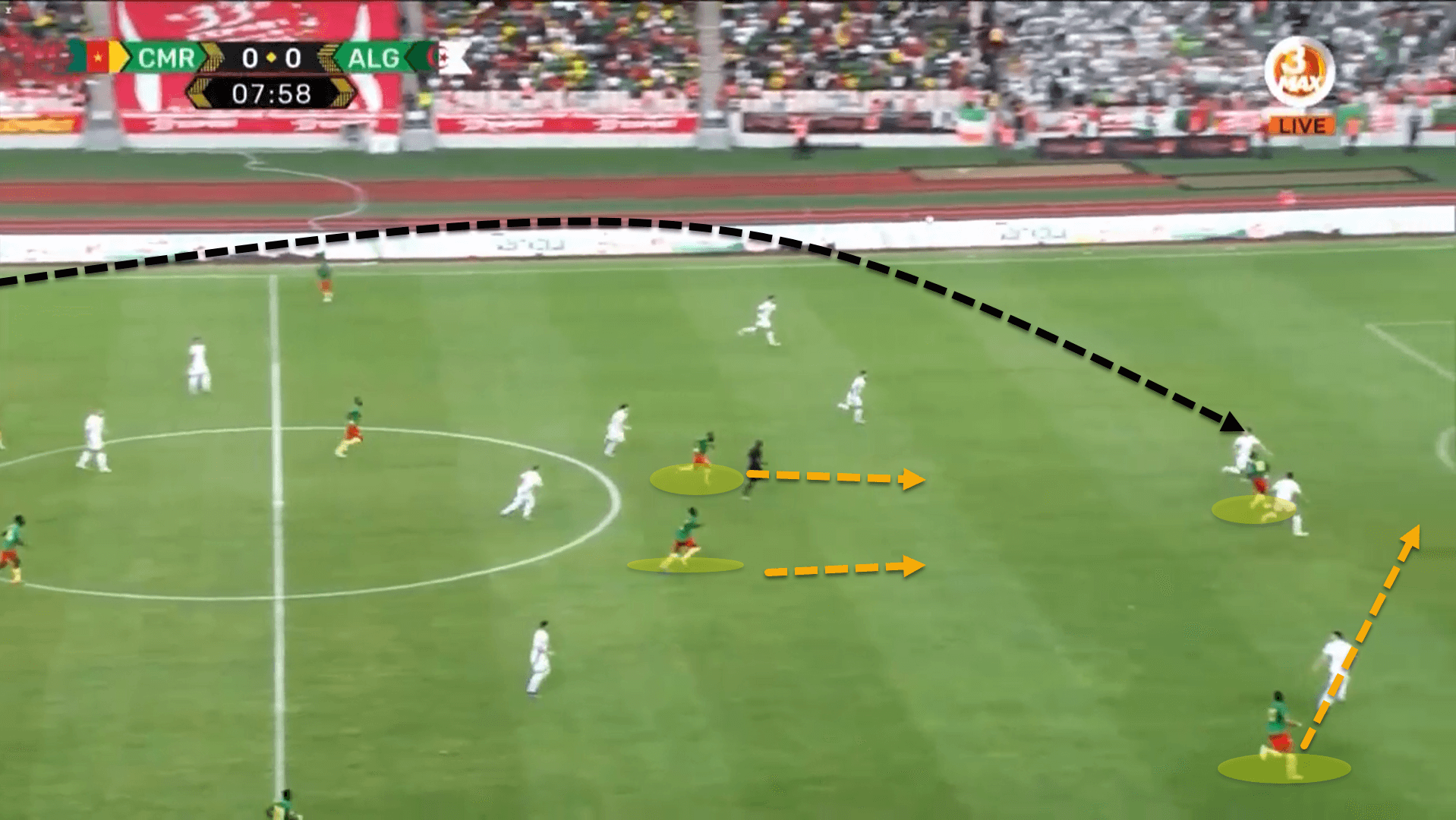
Once the ball is played long towards the frontmen, the objective for Cameroon is to win the second ball by supporting the ball-challenger, whether that be by making a run in behind in case of a flick or else by moving in front of the player to collect it if it’s knocked down.
In the last image, the left centre-back has hit the ball directly to the centre-forward who has managed to drag the entire Algeria backline into a deeper position. From there, the two nearest players move closer to the ball as quickly as possible to support the striker and win the second ball, retaining possession in the final third where they can crack on in a decent position.
Players like Choupo-Moting and Vincent Aboubakar are excellent aerially and with their hold-up play, making direct passes an efficient option for Cameroon to bypass pressure.
The same principle applies when Cameroon are set up in a structured positional attack around the halfway line and are attempting to break down an opponent’s mid-to-low defensive block.
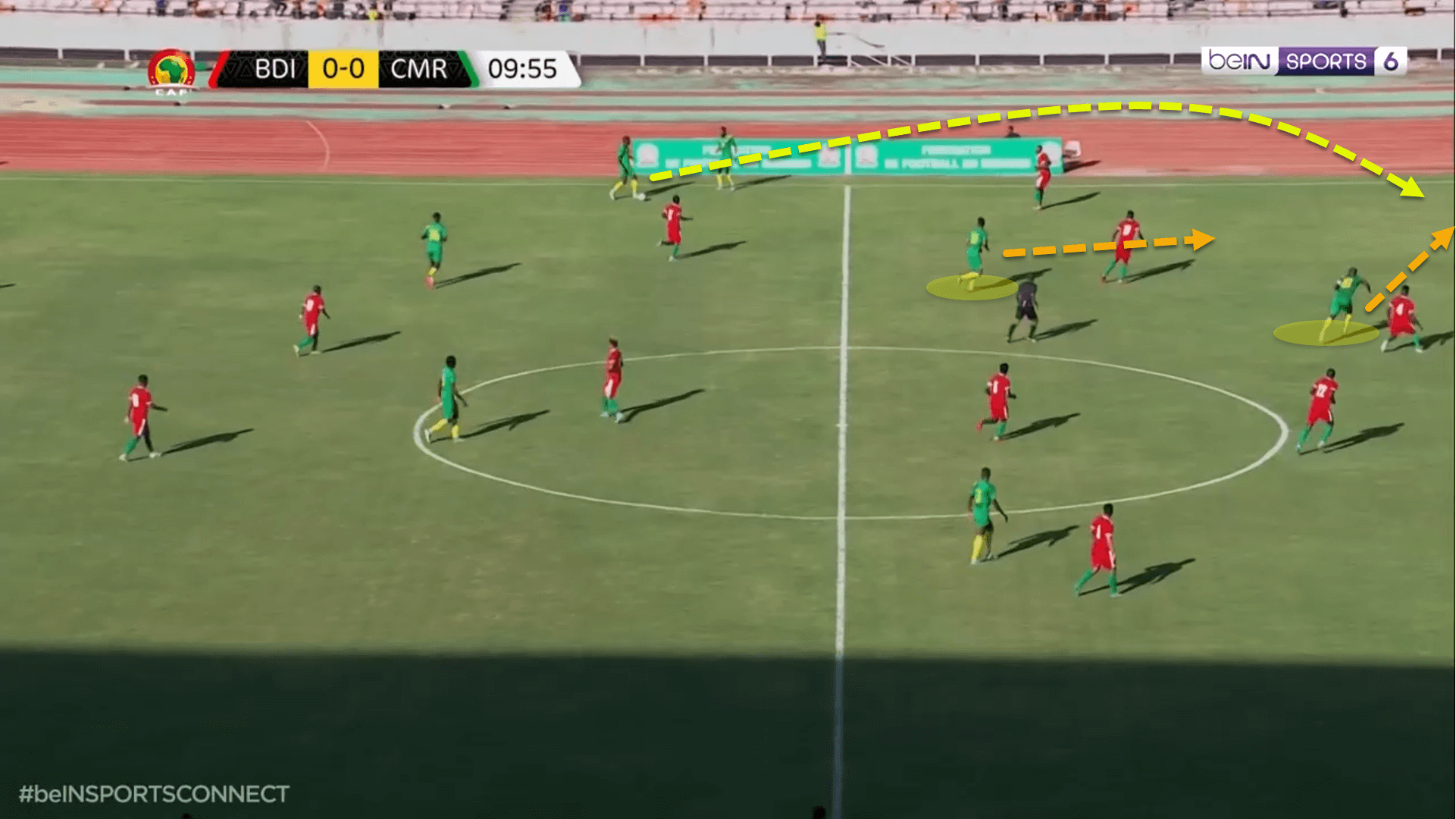
Again, here, we see both Cameroon’s central midfielder and centre-forward making a run in behind the Burundi backline which is positioned relatively high in a medium-level defensive block.
Instead of trying to play through the tight areas, which requires an incredible level of technical skill, Song wants his players to hit the channels and then look to cross the ball where they can pack the box, giving them the best possible opportunity to score with the aerial prowess of forwards like Choupo-Moting, and Aboubakar and the deep, late runs of Zambo-Anguissa and Onana.
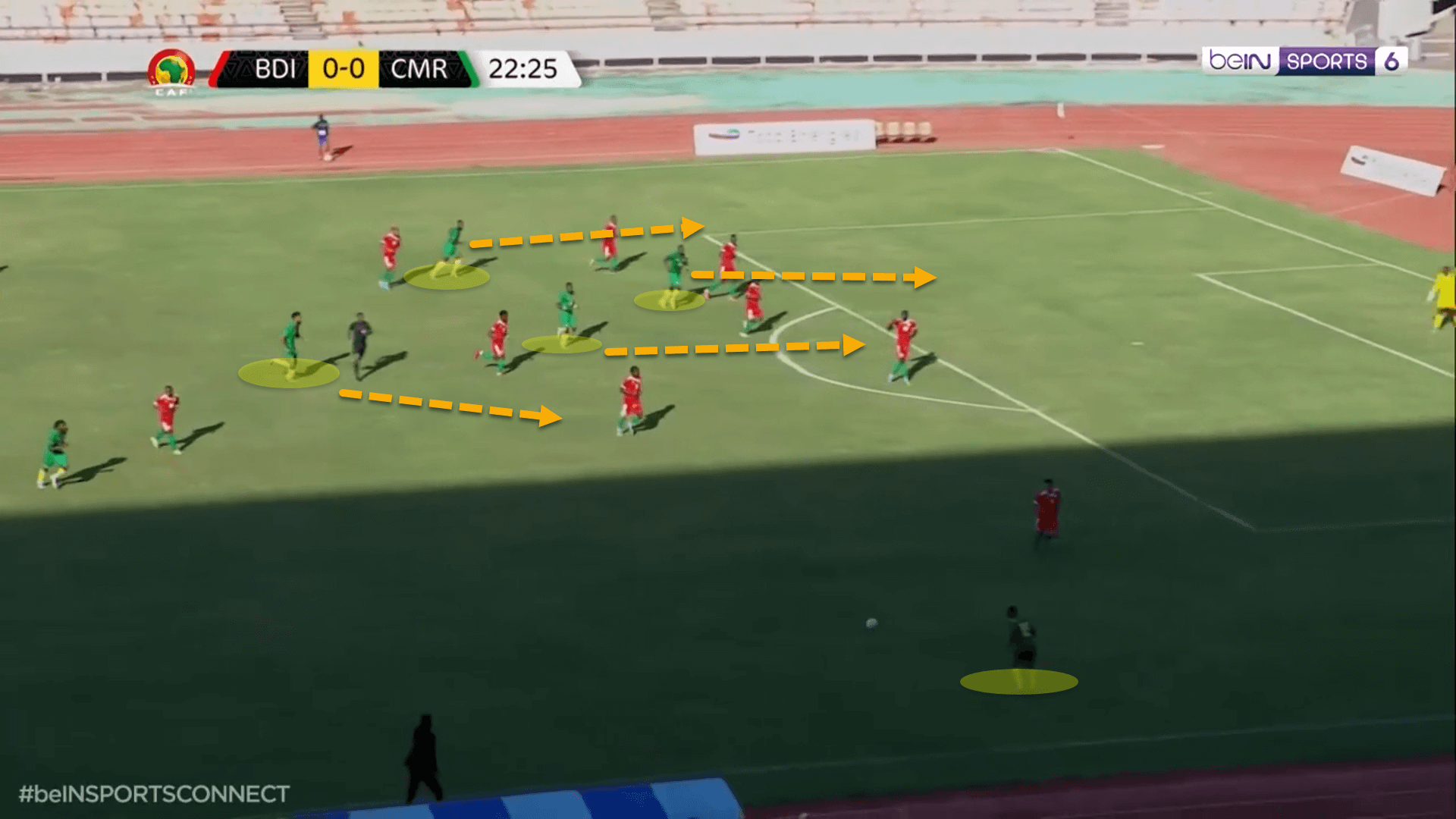
In attack, there is nothing overly innovative or astonishing about Cameroon. However, they do have proven, European quality among their ranks in attacking positions across the forward line and the advanced midfielders.
One of the key elements of Cameroon’s play is that it is very direct and very physical. Brazil, Serbia and Switzerland will have a tough battle on their hands in the middle of the park, especially against Zambo-Anguissa and Onana, while the backline will need to be wary of the forward runs of Toko Ekambi and Aboubakar as well as trying to match Choupo-Moting in the air.
Defensive Phase
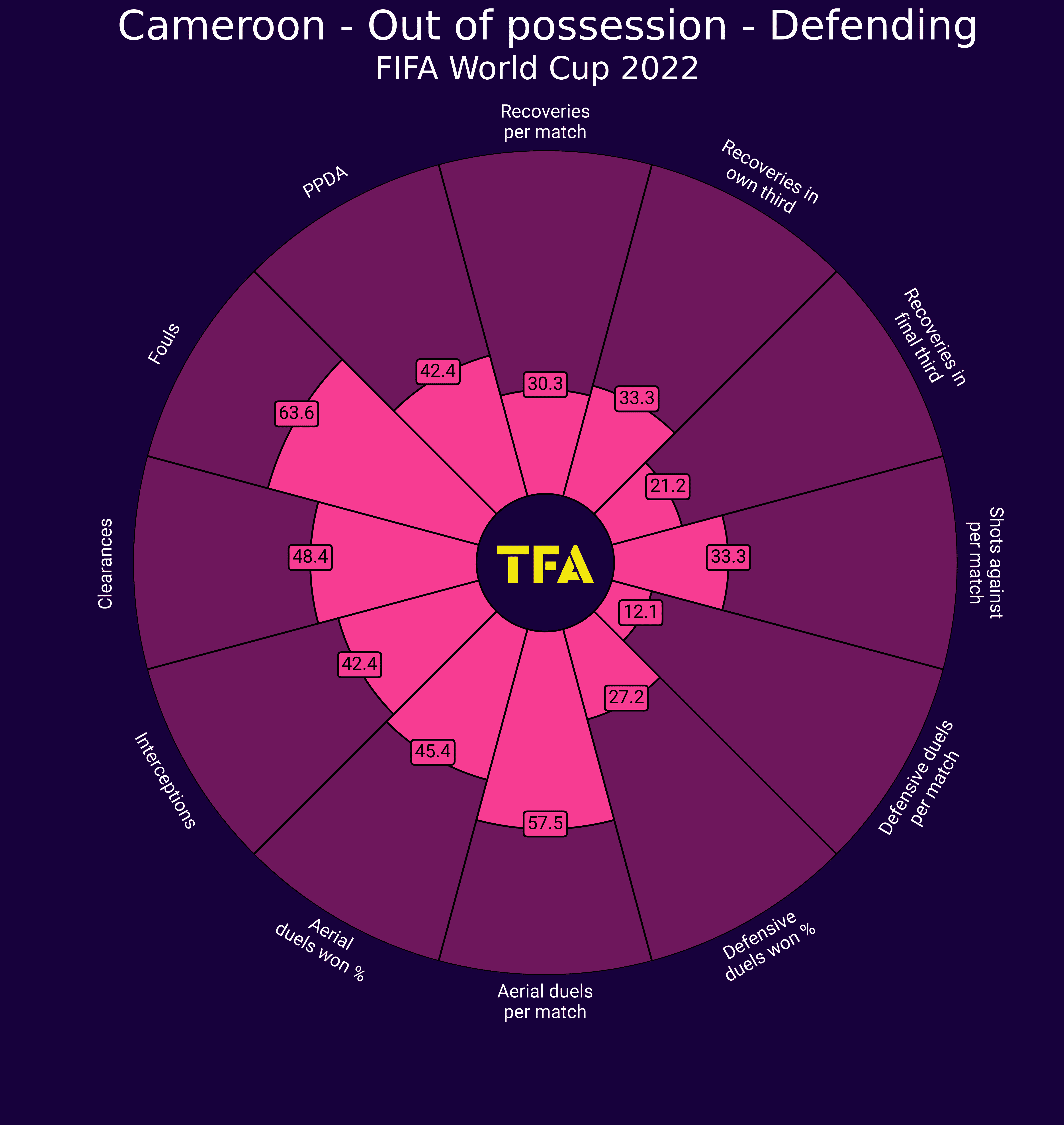
Cameroon are one of the highest pressing sides in Africa, certainly out of the teams from the continent that have qualified for the upcoming Qatar World Cup.
The Indomitable Lions are quite a brute side in possession, hitting the channels and crossing into the big men in the box, quite stereotypical of the English game for several decades before the turn of the Century. However, out of possession, Song is a highly progressive coach.
The gaffer wants his side to press high up the pitch, stifling the opponent’s build-up play and attempting to win the ball in very dangerous areas where they can transition from defence to attack in an instant and try to create opportunities.
At the AFCON, Cameroon boasted a PPDA of 8.23 which was one of the lowest in the tournament. It’s highly likely that at the World Cup, as Cameroon won’t have much of the ball, they will be pressing in the attacking third, looking to force turnovers.
During the build-up phase, Cameroon’s pressing structure is man-oriented. Essentially, each player is tasked with tightly marking one of the nearest passing options for the opposition.
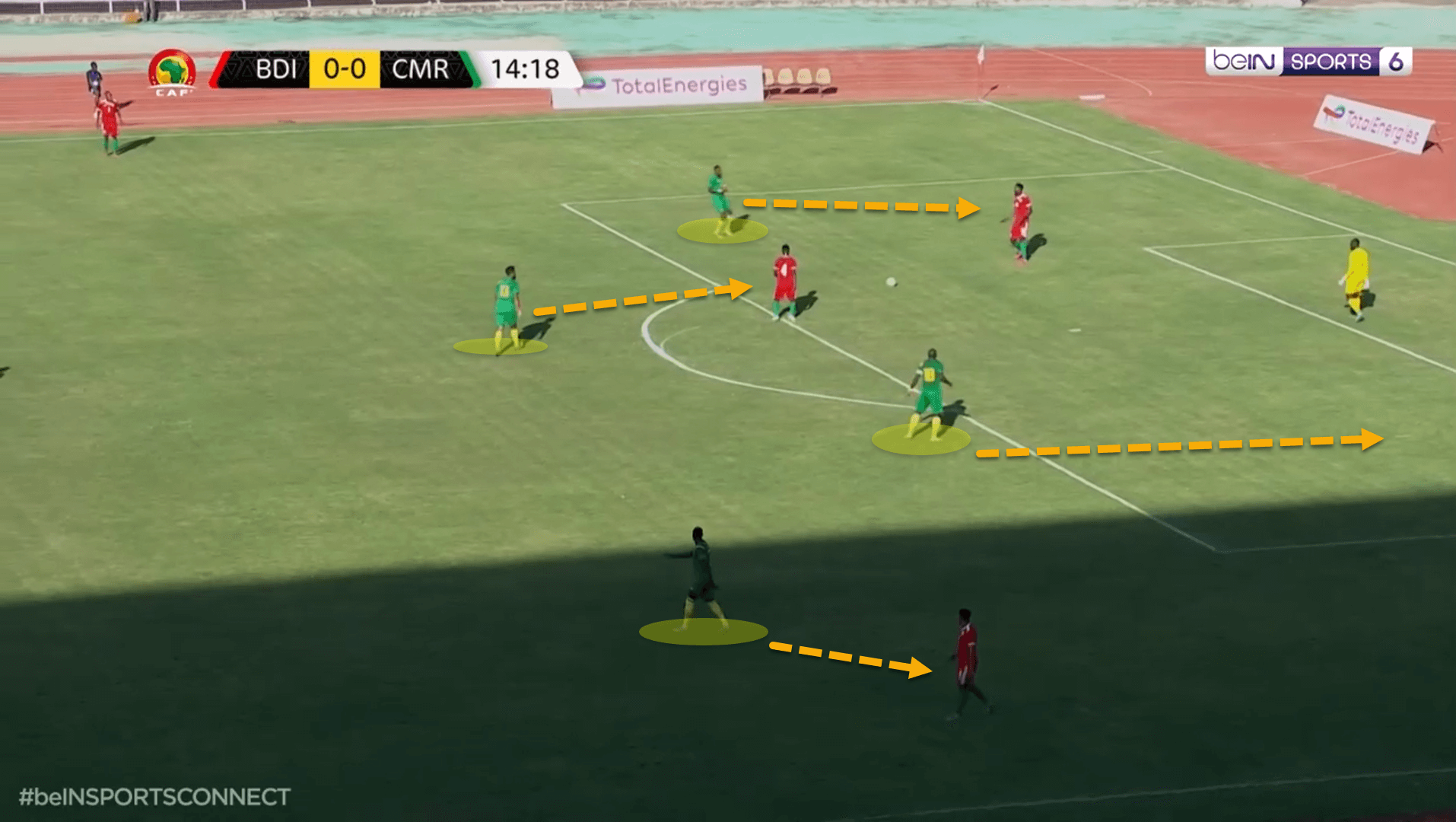
Here, the players have all been assigned a man to mark when Burundi are attempting to pass out from deep. Each individual must be tight to their marker and be ready to aggressively challenge for the ball once the player receives it.
When pressing in a high block, Cameroon are actually really effective and cause a lot of trouble for their opponents which can be seen from the following data visual:
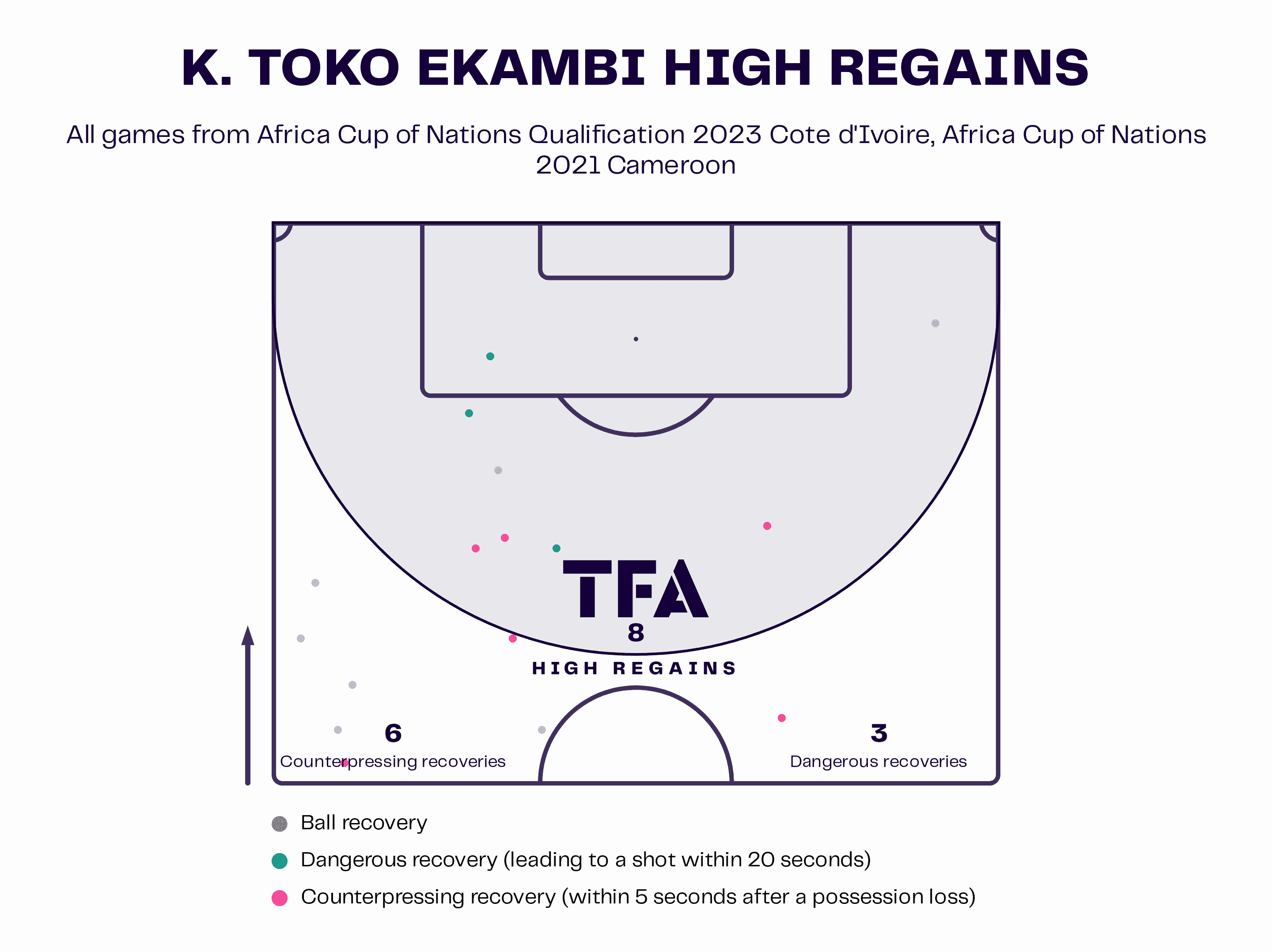
Since AFCON in 2021, Toko Ekambi, who has been used as a winger as well as a centre-forward, has registered 8 high regains, 6 counterpressing recoveries and 3 dangerous recoveries.
However, Song has a tendency to only order his players to press against lesser opponents as these are games where Cameroon have the best opportunity to win their individual duels against each man.
In matches against teams of greater quality, such as Algeria or Morocco, Cameroon have primarily dropped off to defend in a compact defensive block, limiting the space behind the backline.
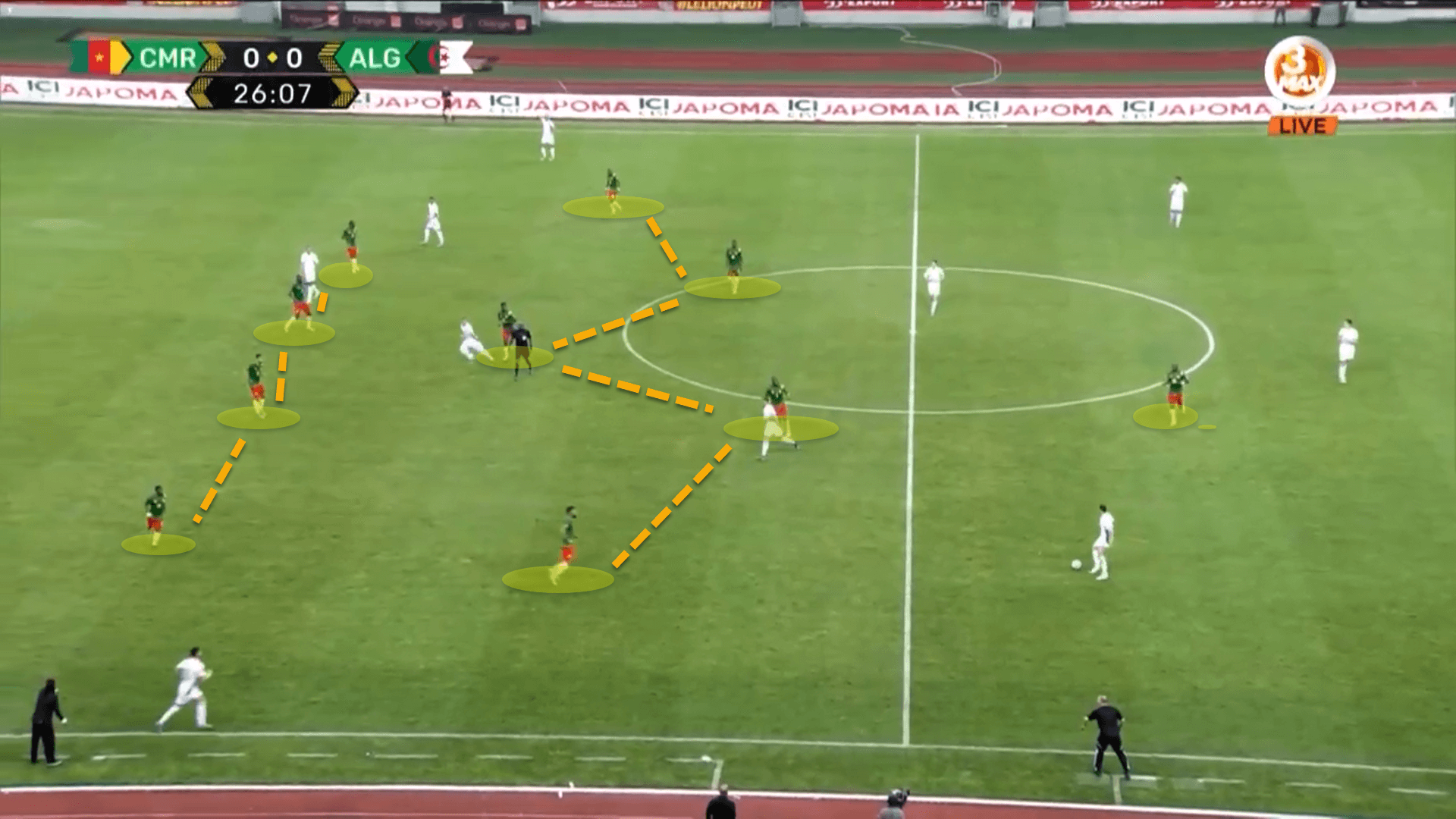
As can be seen from this image, Cameroon’s 4-1-4-1 defensive block is narrow between the lines, with the first and second lines ensuring that the player in possession cannot penetrate their structure by playing through the central spaces. Access through the central corridors has been curtailed and Algeria are restricted to passing out wide.
Song deploys what is commonly referred to in the football analytics stratosphere as a zonal block. This means that the primary aim for the Cameroonian players is the protect the space inside the defensive block. If an opponent plays the ball inside the lines, the players must gang up to either win back possession or force a pass back outside before recouping the same shape.
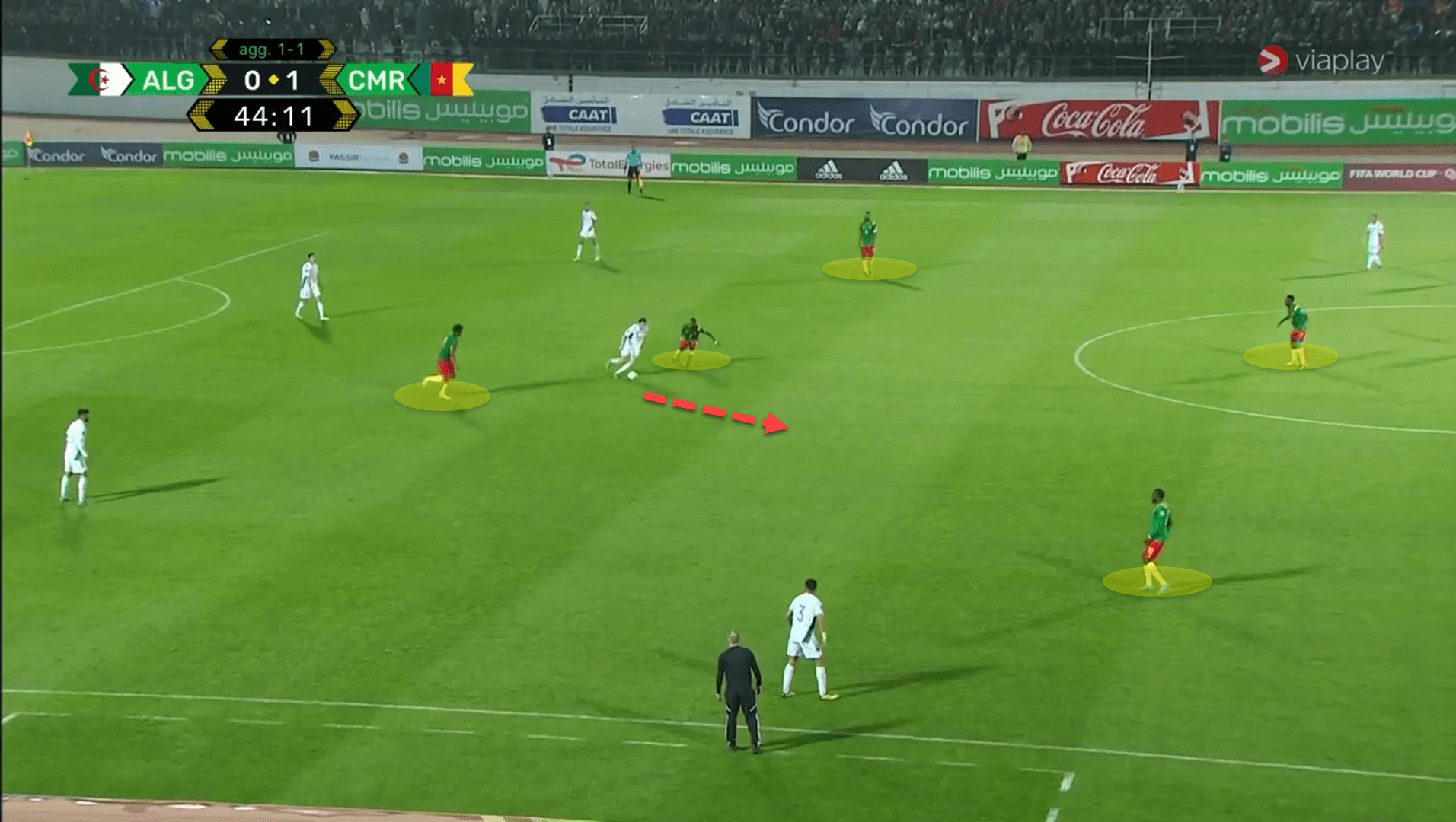
Here, the Algerian midfielder has received and turned on the ball. In an attempt to negate the ball carrier carrying the ball further, the two nearest players quickly close him down.
Over the past calendar year, the Indomitable Lions have conceded just 0.8 goals per game, although this wasn’t always under Rigobert Song himself.
Nonetheless, this is still a pretty good record, but Cameroon will face three incredibly difficult opponents in Group G, particularly against the attacking prowess of Brazil with the likes of Neymar, Antony, Raphinha, and Firmino, among others.
The sturdiness of Cameroon’s defensive block will certainly be put to the test in their three group matches.
Transitions
Transitions are not overly important to the overall tactical set-up of Cameroon. While the vitality of both attacking and defensive transitions cannot be overstated in football, the Indomitable Lions can often look slightly rogue with how they handle both aspects of the game.
Defensively, there is more of a game plan or at least an idea of how to act in this phase. Unlike the titans of European football such as the Netherlands, Germany, Italy or England, Cameroon don’t counterpress.
Counterpressing is a collective effort from numerous nearby players in a structured manager to close down the ball carrier, cutting off a counterattack at its source. Song’s men are merely looking to delay their opponent’s breakaway. This can be through fouling or by genuinely making an excellent tackle.
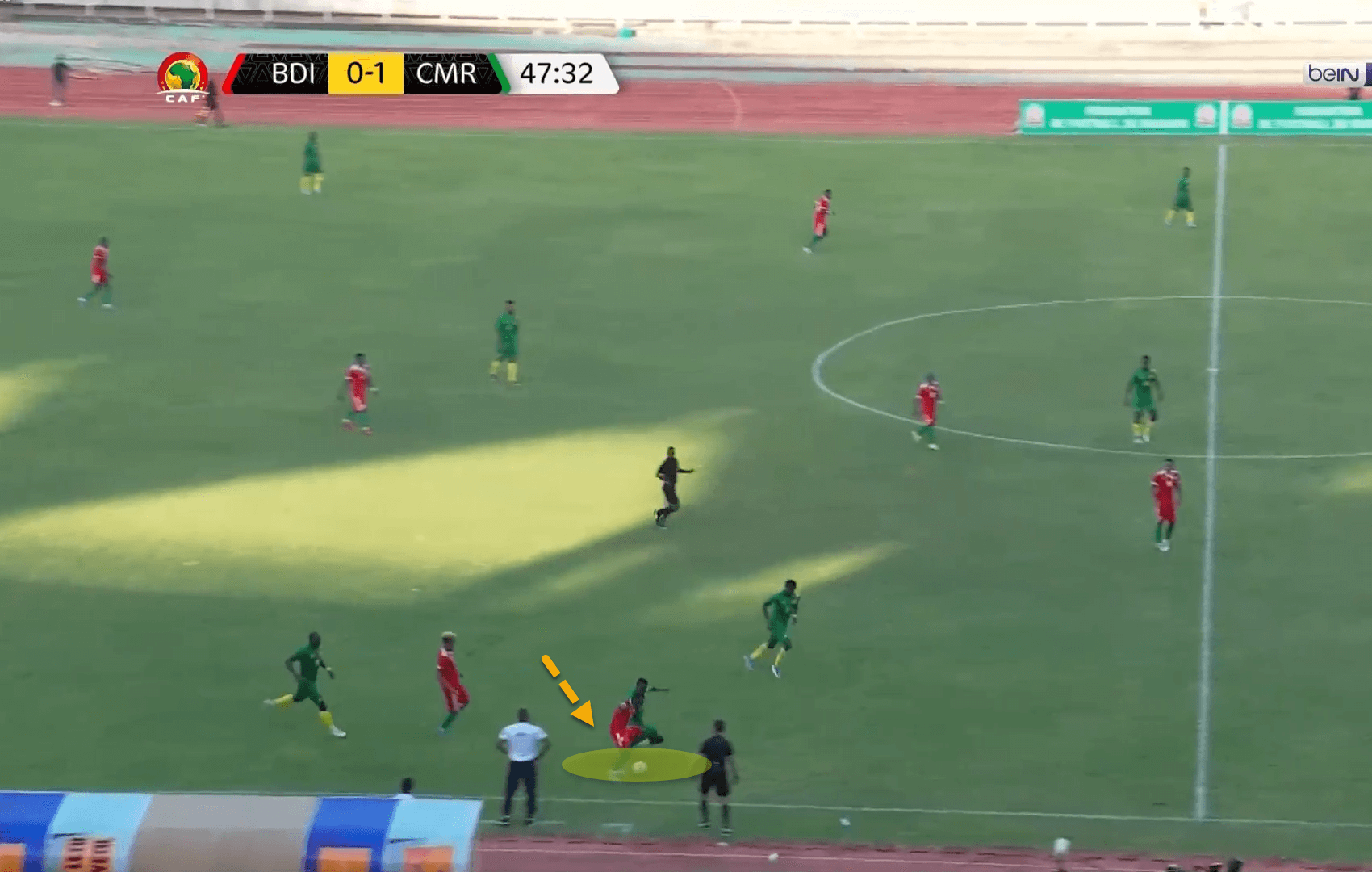
In this example against Burundi, the Cameroon player tracking back shuttled the carrier out wide, closing off the possibility of the attacker playing back inside. Using the touchline, the defender can then make a challenge to win the ball back or at least force the ball carrier to turn and play backwards, buying his teammates time to regain their defensive shape.
Basically, the aim is to delay the counterattack to allow as many players to get back behind the ball as possible where Cameroon can then recover into their defensive block.
When attacking, the manager allows his players to be freer with their movement, emphasising plenty of ball-carrying, dribbling past opponents and running in behind.
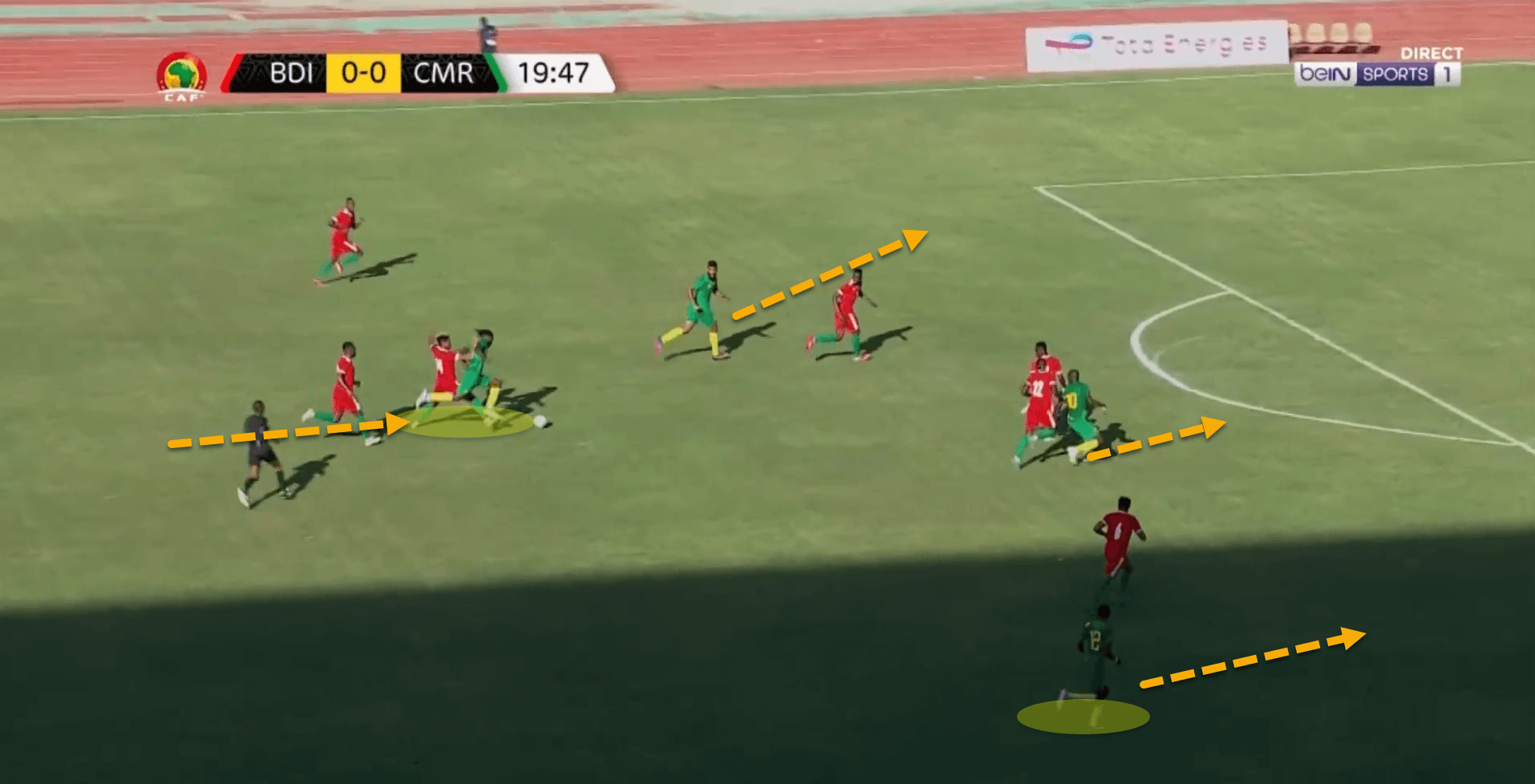
Having players such as Zambo-Anguissa who is an excellent ball carrier as well as Jean Onana while Aboubakar and Toko Ekambi move beyond the opponent’s backline is instrumental to Cameroon being dangerous during attacking transitions.
Defenders
Nouhou Tolo on the left and Collins Fai on the right will be important at providing width for Cameroon who like to invert their wide forwards and so this pair will be tasked with holding their position in advanced areas and putting crosses into the box for the forward line.
Meanwhile, Jean-Charles Castelletto and Nicolas Nkoulou, providing this will be the duo in the middle of the back four, could form a decent partnership for the African nation. The duo, who have both played at a very high level in Europe, can offer a mix of energy and experience which will certainly be needed, particularly against Brazil.
Furthermore, André Onana will be vital at initiating Cameroon’s attacks by either playing short and/or going direct to the frontline, while also keeping the side in games against some of the best players Europe has to offer.
Midfielders
Samuel Gouet has been Song’s preferred option as the ‘6’ for Cameroon over the past calendar year. The Mechelen midfielder will be instructed to make passes into the space between the lines to the forward line and advanced midfielders while also protecting the backline during transitions.
It is further forward in the middle of the park where Cameroon possess the most quality. Jean Onana and Zambo-Anguissa are two incredibly exciting midfielders. Both are wonderful at carrying the ball and will be tasked with supporting the frontmen in attack but also with offering energy in the centre out of possession to win the ball back.
Off the bench, Song can even rely on the likes of Pierre Kunde and Olivier Ntcham to come on during games and put in a shift when Gouet, Onana and Zambo-Anguissa tire out.
Attackers
In attack, Cameroon are stacked with experience, power, pace, strength, intelligence and goalscoring ability with players such as Vincent Aboubakar, Choupo-Moting and Toko Ekambi who have played at the highest level in Europe.
However, the depth from the bench will be equally important. Bryan Mbeumo and Georges-Kévin Nkoudou can come onto the field and give Song something different and score goals, as well as create chances.
Key player
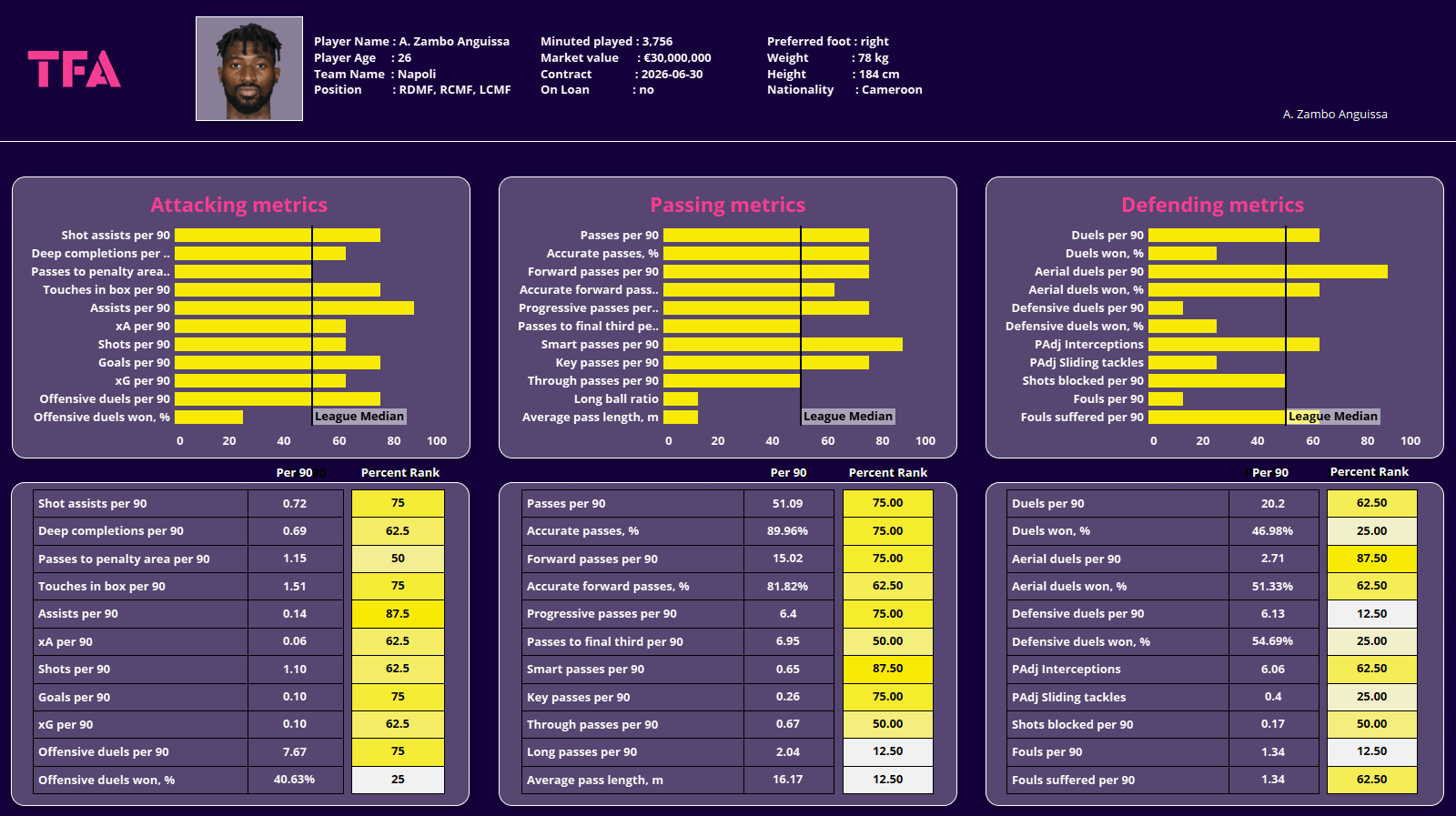
Cameroon have several excellent players within the squad, especially those who are applying their trade at some of Europe’s biggest clubs including André Onana at Internazionale and Choupo-Moting at Bayern Munich, and so it was extremely difficult to pinpoint which player would be absolutely key for the Rigoberto Song in Qatar.
However, Total Football Analysis has selected Franck Zambo-Anguissa as the main man for the Indomitable Lions.
Having failed to adapt to life in the Premier League with minnows Fulham, the midfield general moved on loan to Villarreal and later Napoli before permanently joining the latter last summer. Now, he is a star performer for Luciano Spalletti’s Serie A table-toppers.
As can be seen from the player’s statistics, Zambo-Anguissa is a menace in the middle of the park. His work rate is exceptional which is evident through his impressive defensive statistics, putting him in the higher percentiles on numerous metrics.
Meanwhile, the Cameroonian is also a wonderful carrier of the ball and can explode through midfield with the ball during the attacking phases as well as transitions.
The 26-year-old will be key for Song’s side in trying to win their midfield battles against Brazil, Serbia and Switzerland which is one of the only ways Cameroon can possibly gain an advantage over their difficult opponents.
Tournament Prediction
Cameroon were handed the short end of the stick when being drawn into Group G alongside Brazil, Serbia and Switzerland and are certainly the underdogs from the quartet.
Getting a result from the most decorated nation in the history of the tournament will be next to impossible, so Cameroon will need to look ahead to Serbia and Switzerland to be the games where they can pick up the points needed to progress to the knockout phase.
Chances are, Brazil will finish top of the group and so the remaining trio will be doggedly battling it out for the final place. Realistically, Cameroon should finish bottom of the foursome but a win and a draw against Serbia and Switzerland could be enough to see Song’s side advance.

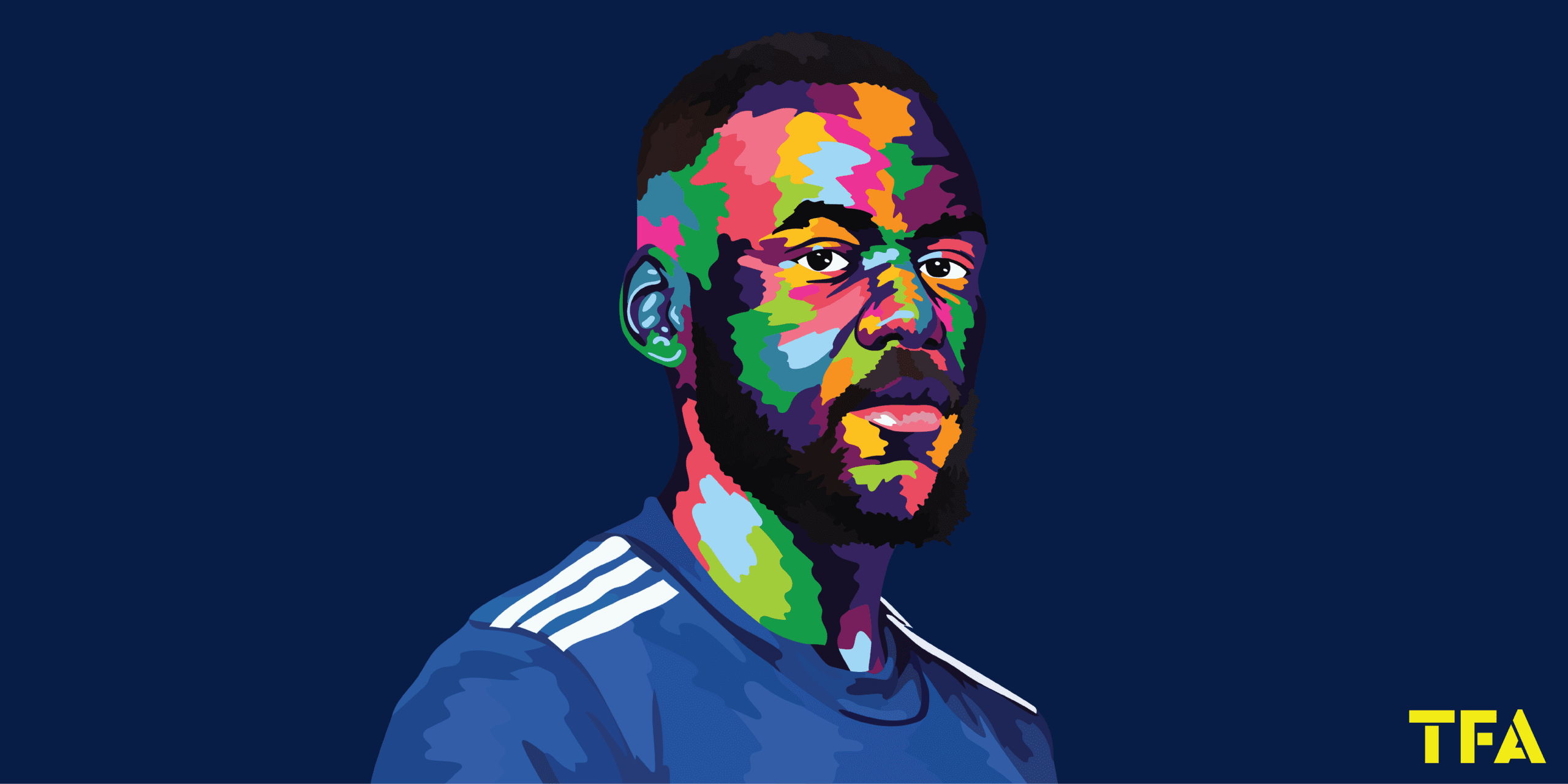

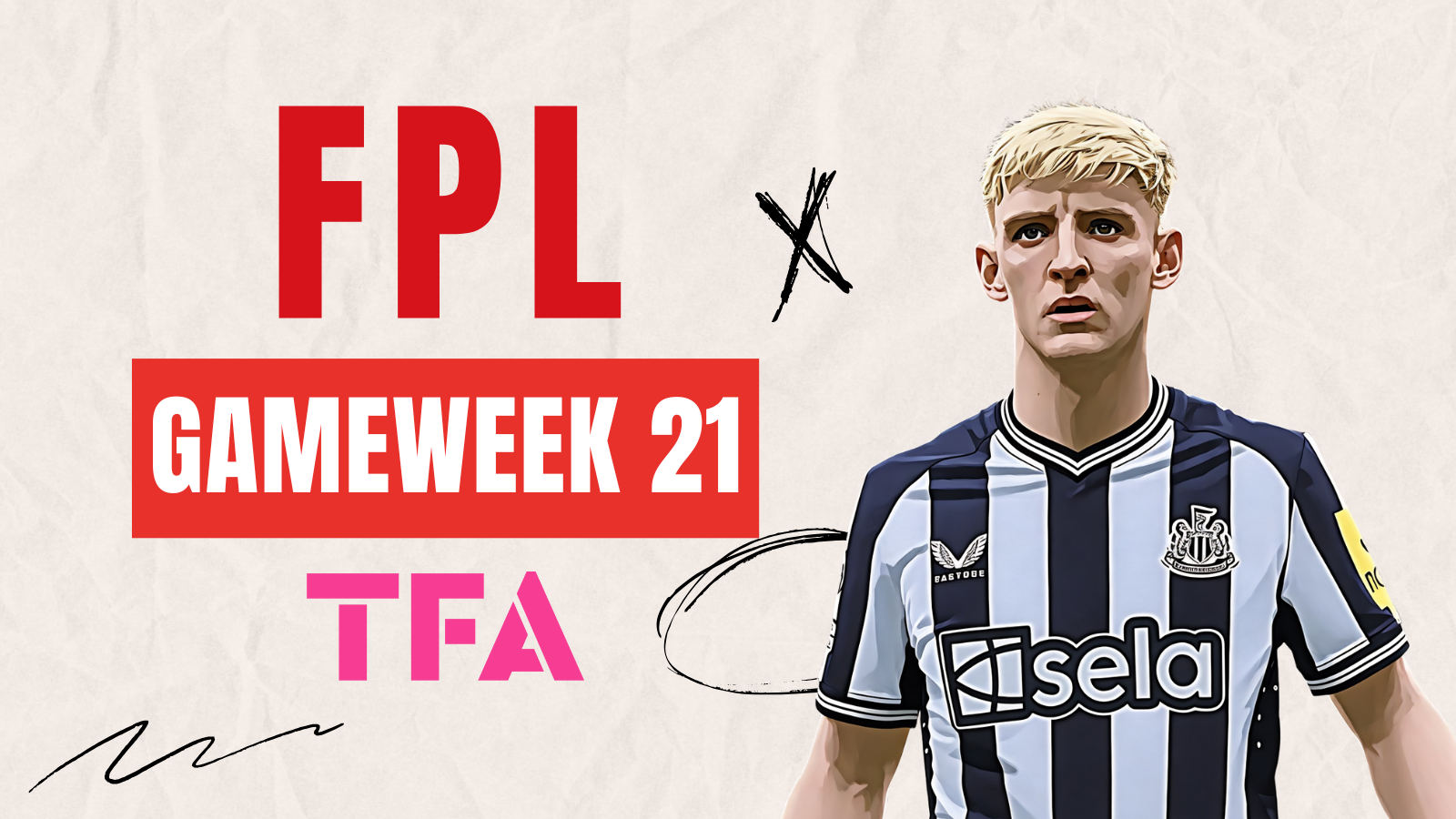

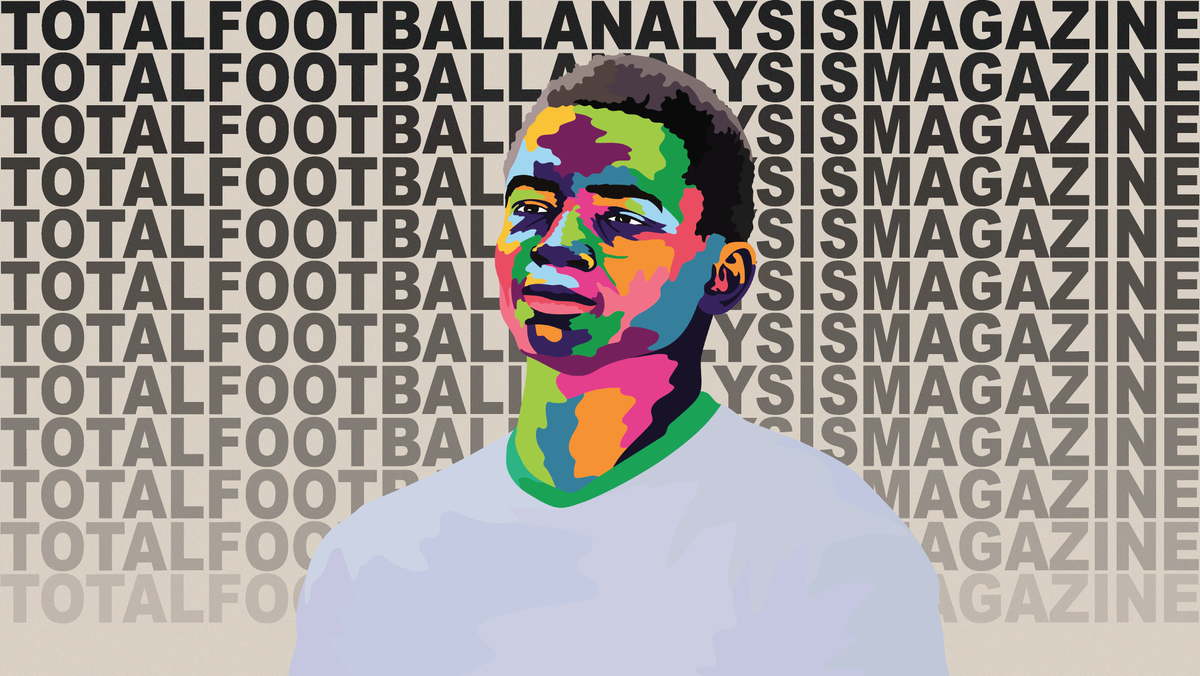
Comments